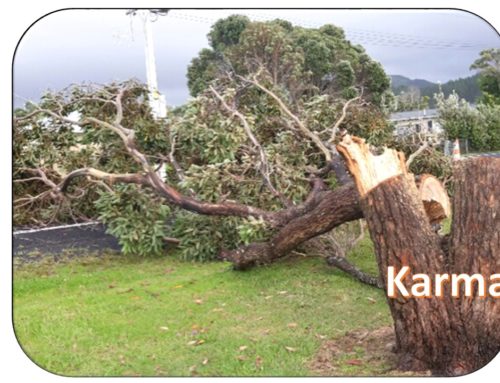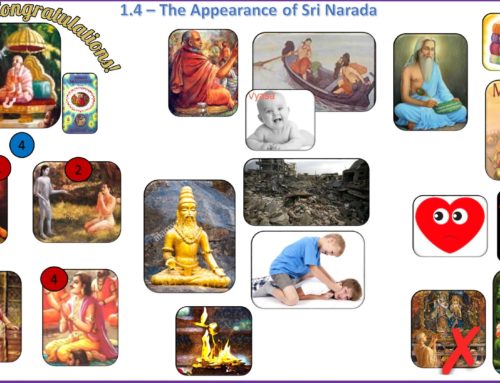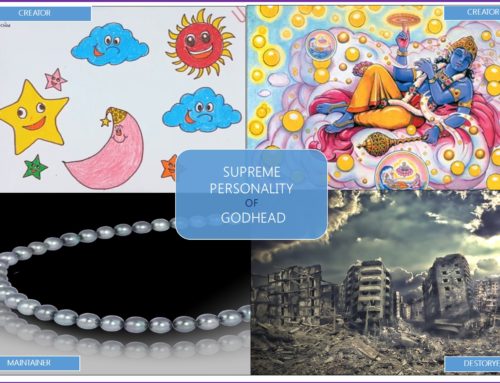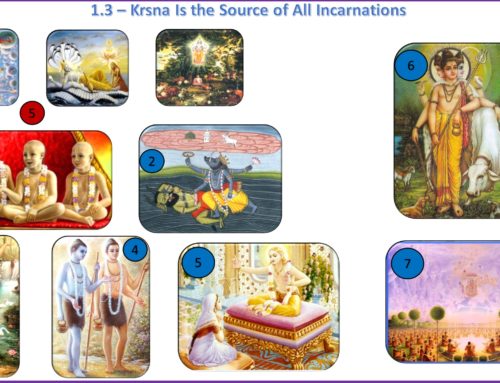In this article we will provide you the step-by-step lesson plan of how by using the Kids Bhagavatam resources and Summary videos one can teach Srimad Bhagavatam to children.
We focused on the following objectives in proposing this teaching methodology.
- Develop a genuine taste for Srimad Bhagavatam.
- Have “Krsna-conscious” fun together with their friends.
- Study Srimad Bhagavatam systematically.
- Learn the overall flow of each chapter.
- Understand key philosophical concepts and absorb them deeply.
- Retain thread/connection between the chapters.
We accomplish the above objectives in the following ways:
- With this fun approach to learning, interactive discussions, examples kids can relate to, kids will most definitely develop a genuine taste for the subject matter as we have seen in our case. Read about our journey and checkout the videos to see how the kids are relishing the subject matter and they are having Krsna-conscious fun together.
- By going chapter by chapter and in each chapter identifying jewels among the verses we accomplish systematic study.
- “Visual summaries” with repetition of the summaries every week until the chapter is complete allows them to easily remember the flow of the chapter.
- In each session we introduce a new philosophical concept (as the chapter reveals) and dive deep using lively discussions, art, drama activities etc.
- Through poems they effortlessly remember thread between the chapters. For example: In SB 1.1 sages ask six questions, which are answered by Suta Goswami in chapters 2 and 3. So if kids remember these six questions in chapter 1, they should be able to connect to the answers given in subsequent chapters.
The Bhagavatam resources available on this site can be used to teach children of various ages. Please find below some suggestions:
- Age 0 – 3 :
- Play the poems, learn and sing it for them, let them memorize and sing.
- Laminate and place visual summaries accessible to them. When they focus on them tell them the chapter summary.
- Age 3 – 4 ½ :
- Play the poems, learn and sing it for them, let them memorize and sing.
- Laminate and place visual summaries accessible to them. Frequently and in short spurts explain them the chapter summary.
- Engage them in art activities.
- Age 4 ½ – 7 1/2: (format explained more in this article)
- Do a presentation using visual summary.
- Cover one or two philosophical concepts per sitting
- Engage them in activities related to the concept.
- Make them learn the poems.
- Age 7 1/2 and above:
- Read the translations, map them to visual summary, find the jewel.
- Read the Jewel description and dive deep with various lenses.
- Let them understand/remember the chapter summaries.
- Let them memorize the poems and remember jewels’s relation to the overall chapter.
sarva-sastrabdhi-piyusa
sarva-vedaika-sat-phala
sarva-siddhanta-ratnadhya
sarva-lokaika-drk-prada
Translation by Gopiparanadhana Dasa: O nectar from the ocean of all scriptures, singualar fruit of all the vedas, rich mine of the precious gems of all conclusive truths, You are the only giver of sight to all worlds.
Surrounding this analogy, we shall organize Kids Bhagavatam chapters as follows:
Each chapter corresponds to a mine. For example, Canto 1 having 19 chapters has 19 mines. We shall delve deep into each chapter and find the philosophical concepts – transcendental jewels. Various resources like – Visual, poetical, theatrical etc., will be used to ingrain the concept deeply into children. We shall call these resources as lenses – the medium through we appreciate the jewel from different perspectives.
Here is the summary of this “mine analogy”:
Chapter (chapter1, chapter2, ..etc.) -> Mine (mine1, mine2,… etc.)
Philosophical concepts –> Transcendental jewels
Resources for parents/children –> Lenses
The following is the comprehensive list of resources we shall provide for each philosophical concept. Note: some concepts may contain only a subset of these as appropriate.
Short poem explaining the concept (to memorize) – Poetical lens
Paintings/illustration, which visualizes the concept – Visual lens
Related verse from our scriptures which encapsulates this concept (to memorize) – Shastric lens
Theatre based activity on this concept (skit/drama/puppets/mime/guessing games) – Theatrical lens
Art/coloring activities centered on this concept – Art lens
Writing/Reading activities to deepen this concept – Literary lens
- Read the description of the jewel.
- Make note of: Definitions, Examples, Connection to the chapter and previous Jewels, questions you would ask them to make it interactive.
- Read Srila Prabhupada’s translation and purports for the verse.
- Learn to sing the poem in tune.
- Read more about the story (if any) mentioned in the Jewel description.
- Collect resources mentioned in various lenses (activities).
- Check the summary video to see how we did it.
Note: The process below is for the age group (4 1/2 – 7 1/2). See the “Age appropriate lesson plan” above to see how to adapt this accordingly.
Prayer/Invocation:
Recite the prayers along with the students.
Review what we covered thus far:
While pointing at the visual summary, summarize the flow of the chapter till now. As you pass through each jewel, refresh again some salient points discussed and ask the children to recite the poem (if any) for the jewel.
New lesson:
Teach the new lesson for that week. Here are some guidelines –
- Mention connection to chapter thus far/connection to previous chapters
- Make it interactive
- Give examples kids can relate to
- Talk about practical application points
- Teach them the new poem (if any)
- Tell the related story as given in the jewel description.
Post-lesson activities:
Engage the kids in post-lesson activities like: art/drama/memorization of shloka etc as mentioned in the jewel description.
Homework:
Children should memorize the new poem(s) taught.
Children could memorize the verse specified in the “shastric lens”.
Children should do the art activities under “art lens” if given and scan and save them in a document.
Children should answer the questions listed under “literary lens”. If older (7 1/2 years and above) they should write down the answers to the questions.
Age 4 ½ – 7 ½ :
- Recollect poems when given some clue about the concept.
- Starting to tell the summary based on visual summary slide with help.
Age 7 ½ and above:
- Oral test: Tell the entire chapter summary by seeing the visual summary slide and sing the poems.
- Written test: Sit for close book written exam based on “literary lens” questions.







